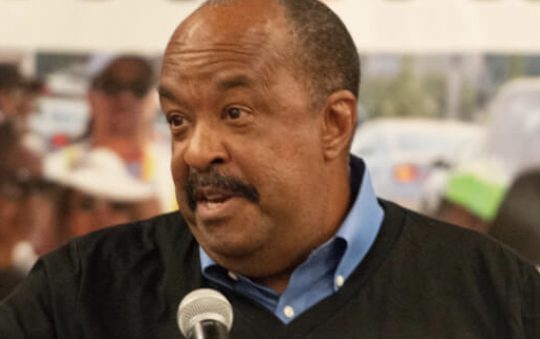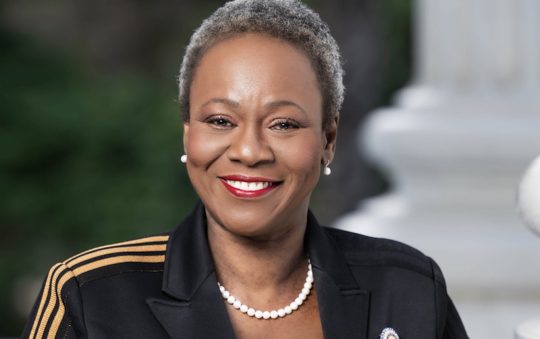 |
| Duke Ellington |
Born Edward Kennedy Ellington, the masterful music he made and left a distinguished legacy to the world. As one of the most important composers in the history of jazz, “Duke” was also a bandleader who held his large group of musicians together continuously for almost 50 years. In addition to conducting, Ellington recorded extensively and toured continuously year after year, which resulted in a body of work so vast that it was still being assessed more than a quarter of a century after his death.
Ellington was born in Washington, D.C. on April 29, 1899, when the nation’s capital had the largest Black population of any American city. It was at the height of segregation and since Black people were relegated to densely populated neighborhoods, they developed their own clubs, cultural organizations, commerce and especially churches. His father, James Edward Ellington (affectionately called “J.E.”) made blueprints for the United States Navy, worked as a butler for a prominent D.C. physician and occasionally “moonlighted” at the White House as a caterer. His mother, Daisy Kennedy Ellington, a high school graduate (a rare achievement at that time) was a homemaker who projected a refined manner and taught him how to live elegantly. Both of Ellington’s parents played the piano; she would play parlor songs and he, operatic airs.
Though Ellington began taking piano lessons at eight years old, he was more concerned with baseball. (Later on in his autobiography “Music is my Mistress,” he would say, “I missed more lessons than I attended”). He attended Garnet Elementary School and Armstrong High School in Washington, D.C. At age fifteen, he wrote his first composition, “Soda Fountain Rag.” He expressed an air of self-confidence that he absorbed from his father. The grace and ease with which he carried himself, along with his dapper dress-wear, gave him the bearing of a nobleman. Thus began the nickname “Duke,” a moniker that stuck with him for the rest for his life.
Music was peripheral in his life at first and through the insistence of his parents, he began to listen, watch and imitate ragtime pianists. During his summer vacations, while visiting Philadelphia and Atlantic City with his mother, Ellington would continue to learn about music when they were on the road. In his late teens, he began to read sheet music and show professional interest in music. He started to play gigs in cafes and clubs, in and around Washington, D.C. He “gravitated” to the “chitlin’ circuit,” as he began to develop a deep love for music. Ellington’s attachment to music grew so strong that he dropped out of Armstrong Manual Training School and in 1916, he turned down a scholarship to study art at the Pratt Institute in Brooklyn even though he had been studying Commercial Art, and was three months shy of graduation.
Between 1917 and 1919. Ellington used his art skills to work during the day and played the piano at clubs and cafes at night. He quickly became a successful ragtime, jazz pianist, bought himself a house and moved out of his parents’ home. Shortly after, he formed his first group, “the Duke’s Serenaders—Colored Syncopators”. In addition to being a member of the group, he also served as their booking agent. Their first engagement was at the True Reformer’s Hall and it netted him seventy-five cents. The group began to travel beyond the Washington, D.C. area into nearby states including Virginia, where they played for private society balls and embassy parties. They played for Black and White audiences alike, which marked a milestone during those racially divided times.
As his career began to blossom, Ellington married his high school sweetheart, Edna Thompson. They were married in July 1918; shortly after, they had a son, Mercer, who grew up following in his father’s footsteps as a bandleader.
The lure of New York’s Harlem Renaissance had a natural calling for Ellington, who left his successful career in Washington, D.C. and the surrounding area, and headed for Harlem. At 24, his leaving the capital as a successful music undergraduate and his moving to Harlem was equivalent to transferring to the graduate school of music. Getting off the train on his arrival, he reportedly said, “This is the world’s most glamorous atmosphere; why, it’s just like the Arabian nights.” At that time, Harlem was called the Black Mecca and musicians were an all important part of it. It was the cultural capital of Black America, and besides the festivities, it was also the home of the National Association for the Advancement of Colored People (NAACP) and the National Urban League. Ellington and his band swiftly blended in, and his performances were mobbed by sold-out crowds. As he moved into Lenox Avenue, one of the main thoroughfares, crowds lined the street to get a glimpse of the man who made the band.
Ellington began learning the ropes—New York style. He played in some of the most highly rated and exclusive clubs, not only in New York, but also in other out-of-state venues including Atlantic City’s Music Box (New Jersey), the Cotton Club and the Exclusive Club (N.Y.). Ellington would spend his days rehearsing his piano revue and at nights, he would lay it all out for the crowds. Referencing one of the clubs, he wrote, “our music acquired new colors and characteristics.
Like many of the entertainers of that era, Ellington experienced his share of the “color” treatment. Though his band was, at one time, the main attraction at the Cotton Club—where Blacks were the entertainers and waiters—it only admitted Whites as customers. That was the prevailing custom in the U.S. society at that time. However, when he began making records, only the quality of his music mattered since his customers only heard his music. In 1924, he made eight records and the following year, he contributed four songs to others.
The sheer volume of his works necessitated Ellington to seek out the services of an agent and in 1927, he found one who also happened to be a music publisher also: Irving Mills. In the music industry, Mills had an eye for talent and went to work on Ellington’s recordings. His (Ellington’s) popularity and his earnings soared as a result of his association with Mills who even took the management burden off Ellington’s shoulders. Then, Ellington moved into the realm of the movies; minor movie appearances and movie scores gave him additional national exposure.
He first appeared in “Black and Tan,” a short, all-Black film for RKO in 1929. Then came the Depression. The band survived the hard times by doing road tours and since he had a huge overseas following, they went to England in the mid-thirties. There was a slum in his career when his mother died in 1935, but he recovered as the big-band era was intensifying. Ellington reached his creative peak in the 1940s and maintained that position for the next decade. Some of his hits were: “Sophisticated Lady,” “It Don’t Mean a Thing,” “Take the A Train” and “Mood Indigo.”
In the mid-50s, the big band era died out as the development of solo vocalists was ushered in, but Ellington continued to belt out hits periodically until his major recording affiliation fizzled out. He returned to prominence at the Newport Jazz Festival in 1957 as he was exposed to a newer audience and also signed up with a new record label. Ellington’s career took on a revival mode as he appeared at other festivals including the Monterey Jazz Festival. In 1958, he did a live television production, a European tour and the movie scores for “Anatomy of a Murder” and “Paris Blues;” the latter was with Sidney Poitier and Diahann Carroll.
During the 1960s, Ellington teamed up with the Count Basie Orchestra and jazz great Coleman Hawkins between his recording contracts and made a variety of records. He was nominated for a Pulitzer Prize in 1965 at 66 years old. Now in the twilight of his career, he performed his first Concert of Sacred Music, which fused Christian liturgy with jazz. It appeared so rewarding that he performed it a dozen times and followed it with two similar types of concerts.
Ellington received the President’s Gold Medal and a Grammy Lifetime Achievement Award in 1966, and the Presidential Medal of Freedom in 1969. In France, he was awarded the Legion of Honor award in 1973. The piano on which he performed the scared concerts is part of a collection in the Smithsonian Museum of American History and the Duke Ellington School of Arts project prepares students for professional careers. It is supported by the Ellington Fund. There is a statue of Ellington at his piano at UCLA’s Schoenberg Hall.
Ellington left a body of musical work when he passed in 1974, a month after his 75th birthday. At his funeral, in New York City, jazz great, Ella Fitzgerald, said, “It’s a very sad day; a genius has passed. His son picked up the reins and carried on his music after the Duke’s death.
“Legends” is the brainchild of Danny J. Bakewell Sr., executive publisher of the Los Angeles Sentinel. Every week it will highlight the accomplishments of African Americans and Africans.






